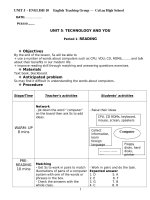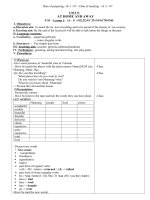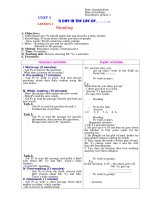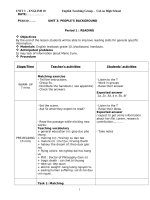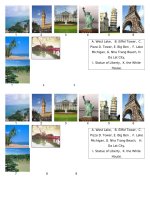Giao an Unit 6
Bạn đang xem bản rút gọn của tài liệu. Xem và tải ngay bản đầy đủ của tài liệu tại đây (135.07 KB, 12 trang )
<span class='text_page_counter'>(1)</span><div class='page_container' data-page=1>
<b>Unit 6: AN EXCURSION</b>
<b> A. READING</b>
Date of preparing: 05/11/2006
Date of teaching: 09/11/2006
<b>I. AIMS AND OBJECTIVES:</b>
<i>- Language content:</i>
+ To introduce the students some new words relating to some famous places .
<i>- Language function: </i>
+ To talk about outdoor activities or activities in an excursion: planning for a trip, preparation, entertainment
activities.
<i>- Educational aims:</i>
+ By the end of the lesson, students talk about school outdoor activities.
<b>1. Language:</b>
<i>a.Vocabulary</i>: cave, excursion, a piece of news, come to an end, have some days offthe shape of the lotus,
picturesque, wonder of the world, permission, persuade
<i>b.Structures</i>: The present progressive and be going to
<b>2. Skills:</b> Intergrated skill.
<b>3. Education factor :</b>
+ Students students will be able to get information about some famous places in Viet Nam .
<b>II. TEACHER AND STUDENTS’ PREPARATION</b>:
<b>1. Method:</b> Communicative approach
<b>2. Techniques:</b> Explaination, Repetition, using pictures, group work, pairwork, multiple choice, gap-filling
<b>3. Materials needed</b>: textbook, pictures of Thien Mu Pagoda, Ha Long Bay, The One-Pillar Pagoda, and Da Lat
<b>4. Students preparation: </b>Prepare some pictures and information about them.
<b>III. PROCEDURE IN CLASS: </b>
1. <i>Stabilization: </i>(3mn)<b> </b>- Greeting.
<b> </b> <b> </b>- Checking about absence.
2. <i>Checking up the previous knowledge: </i>(7mn)
- Asks Students to tell about the usage of “used to” and give an example
- Students answer.
<b>Teaching steps and</b>
<b>time</b>
<b>Teacher’s activities</b> <b>Students’ activities</b> <b>The lesson content</b>
<b>I. Presentation of </b>
<b>the new materials</b>
<b>* Lead-in</b>
<b> </b>(5mn)
<b>* Pre-reading</b>
(10mn)
- Asks Ss to work in groups
and make a list of famous
places in Viet Nam.
(The group with the longest
list will be winner.)
- Gathers ideas and has Ss
give some information about
them.
- Asks the students to
work in pairs: match the
photos with the information
in the book, then tell each
other which of the places you
would like to visit and give
reasons.
- Calls some students to
answers in front of the class.
- Gives feedback and corrects
- Teaches some new words
<i>+ cave (n) + </i>
- Work in groups.
- Answer.
- Work in pairs.
<b>Unit 6. AN EXCURSION</b>
<b>A. READING</b>
1. New words.
<i>+ cave (n): hang động </i>
<i>+ excursion (n) cuộc đi chơi </i>
<i>+ a piece of news: một vài tin </i>
<i>+ come to an end: sắp kết thúc </i>
<i>+ have some days off : nghỉ vài </i>
<i>ngày</i>
<i>+ permission (n):sự cho phép </i>
<i>+ persuade (v): thuyết phục</i>
<b>* The Progressive: </b>
<b>S+be+V-ing</b>
2. Reading the passage:
<b>* Task 1: Multiple choice:</b>
1C 2D 3A
<b>* Task 2: Answer the </b>
<b>questions:</b>
1.<i> They are going on a trip when</i>
<i>they have some days off after the</i>
<i>first term.</i>
</div>
<span class='text_page_counter'>(2)</span><div class='page_container' data-page=2>
<b>* While-reading</b>
( 10mn)
<b>* Post-reading</b>
(5mn)
<b> </b>
<b>II.Consolidation</b>
(3mn)
<b>III. Homework</b>
(2mn)
<i>excursion (n) </i>
<i>+ a piece of news + come </i>
<i>to an end + have some </i>
<i>days off </i>
<i>+ permission + </i>
<i>persuade </i>
- Explains the meaning of the
words
- Read the words.
- Introduces Ss the present
progessive and be going to.
- Sets the scene: You are
going to read the letter from
Lan to her friend, Minh about
her recent fantastic
excursion to a cave near
HaNoi. You read the letter
and do the tasks followed.
<b>*Task 1:</b>
- Asks students to read the
letter individually and choose
best answer A, B, C or Dto
complete each of the
sentences.
- Tells Ss to share their
answers with a friend.
- Calls some students to
present and explain their
answers in front of the class.
- Correct mistakes.
<b>* Task 2:</b>
- Has students to work in
pairs and answer the
questions
-Walks around the class and
offers helps if necessary,
then call on some pairs to act
out the activities in front of
the class.
- Asks the students to fill in
the summary of the letter
with a suitable words.
- Helps Ss do this exercise,
then has them compare their
answers with a partner.
- Calls some students to
answer.
- Comments and gives correct
answers.
- Retells the content of the
text.
- Asks them to write
homework in their notebooks.
-Answer.
<i>+ Number 1 is Thien Mu </i>
<i>Pagoda.(d)</i>
<i>+ Number 2 is Halong Bay.</i>
<i>(b)</i>
<i>+ Number 3 is One-Pillar </i>
<i>Pagoda.(a)</i>
<i>+ Number 4 is Da Lat city.</i>
<i>(c)</i>
- Listen and take note
- Listen and repeat.
- Listen
- Read the letter and do
task 1.
- Share the answers.
- Present and explain.
- Listen.
- Work in pairs.
- Answer.
- Work individually.
- Do and compare the
answers.
- Answer.
- Listen.
- Listen
- Write in the notebooks.
<i>because they want to understand</i>
<i>their Geography lesson better </i>
<i>and many of them have never </i>
<i>been inside a cave.</i>
3<i>. It’s only over 20 km.</i>
4.<i> they are going to make a two </i>
<i>– day trip and have a night </i>
<i>campfire. They are bringing </i>
<i>their own food and sharing </i>
<i>buses with some other classes to</i>
<i>make the trip cheap.</i>
5.<i> Lan an anxious about her </i>
<i>parents’s permission. They may </i>
<i>not want to let her stay the night</i>
<i>away from home.</i>
<b>* Summary:</b>
1. is going to go on
2. some caves
3. want to see
4. have learnt 5.
their trip
6. only problem
7. to persuade them
8. her classmates
<b>* Homework</b>:
+ Do all exercises in the
notebook.
+ Learn by hear the summary.<i> </i>
</div>
<span class='text_page_counter'>(3)</span><div class='page_container' data-page=3>
<b>Self – evaluation: </b>Should give sts to prepare pictures and present.
Spend too much time in leading
<b>Unit 6: AN EXCURSION</b>
<b>B. SPEAKING</b>
<b>I. AIMS AND OBJECTIVES:</b>
<i>- Language content:</i>
+ To help students express agreements and disagreements to an idea and give opinions.
<i>- Language function: </i>
+ To talk about a boat trip abroad.
<i>- Educational aims:</i>
+ To help the students know to choose the suitable seat on a boat trip.
<b>1. Language:</b>
<i>a.Vocabulary</i>: sundeck, get sunburnt, travel sickness
<i>b.Structures</i>:
<b>2. Skills:</b> Intergrated stills .
<b>3. Education factor :</b>
+ By the end of the lesson, the students will be able to talk about the seat plan on a boat trip on Lake Michigan in
Chicago.
<b>II. TEACHER AND STUDENTS’ PREPARATION</b>:
<b>1. Method:</b> Communicative approach
<b>2. Techniques:</b> Explaination, Repetition, pairwork, giving opions.
<b>3. Materials needed</b>: textbook, chalk, board
<b>4. Students preparation: </b>Prepare the lesson at home.
<b>III. PROCEDURE IN CLASS: </b>
<i>1. Stabilization: </i>(3mn)<b> </b>- Greeting.
<b> </b> <b> </b>- Checking about absence.
2. <i>Checking up the previous knowledge: </i>(7mn)
+ Asks students some questions about Lan’s excursion.
1. When are Lan and her classmates going on a trip?
2. How far Thay Pagoda from their school?
3. What is Lan anxious about?
+ Suggested answers:
1. When they have some days off after the first term.
2. It’s over 20 kilometres
3. She is anxious about her parents’ permission.
<i>3. The new lesson:</i>
<b>Teaching steps and</b>
<b>time</b>
<b>Teacher’s activities</b> <b>Students’ activities</b> <b>The lesson content</b>
<b>I. Presentation of </b>
<b>the new materials</b>
<b>* Warm-up</b>
(5mn)
- Gives a crossword with
7 across words and one
down word.
- Divides the class into
two groups.
- Gives information of the
words in the across and
then find out a key word.
1.Your father’s brother.
( UNCLE)
2. Means of transport on
- Work in groups and
find the words.
* A key word:
CHICAGO
1 U N C L E
2 S H I P
3 R I V E R
4 E X C U R S I O N
5 F A R M E R
6 N G U Y E N D U
</div>
<span class='text_page_counter'>(4)</span><div class='page_container' data-page=4>
<b>* Pre-practice</b>
(5mn)
<b>* </b>
<b>Cotrolled-practice</b>
(10mn)
water. (SHIP)
3. Where do we often go
fishing? (RIVER)
4. A short journey usually
for pleasure.
(EXCURSION)
5. A person who works on
a farm. (FARMER)
6. The name of our
school. (NGUYEN DU)
7.He sees a dentist
because he has a ………
(TOOTHACHE)
- Leads the students to the
new lesson <i>“Tim’s </i>
<i>class is going on a boat </i>
<i>trip on Lake Michigan in </i>
<i>Chicago. Raed the </i>
<i>information about some of</i>
<i>the participants to know </i>
<i>their problem and their </i>
<i>wishes”.</i>
- Teaches some new
words.
<i>+ sundesk</i>
<i>+ get sunburnt</i>
<i>+ travel sickness</i>
<i>+ refreshments</i>
<i>+ occupied </i>
- Has Ss make sentences
with the words above.
<b>* Task 1</b>
- Has Ss read the
information about some of
the participants in task 1.
<b>* Task 2:</b>
- Asks Ss to work in
groups: Read the seat
plan carefully and decide
the best seat for each
person, using the
information in task 1.
- Further explains the seat
plan.
- Suggests some useful
structures:
<i>+ I don’t think so.</i>
<i>+ To be suitable for</i>
<i>+ Why / Why not?</i>
<i>+ What do you think?</i>
<i>+ What’s your idea?</i>
<i>+ Had better</i>
- Tells Ss to conduct the
conversation like the
example in the book.
- Walks around the class
- Listen.
- Listen and take note.
- Make sentences.
- Read the information
in task 1.
- Work in groups and
conduct the
conversation.
- Listen to teacher’s
instruction.
- Present the
conversation in front of
<b>Unit 6 AN </b>
<b>EXCURSION</b>
<b>B . SPEAKING </b>
<b>* New words:</b>
<i>+ sundesk (n): boong taøu</i>
<i>+ get sunburnt (v): rám nắng</i>
<i>+ travel sickness (n): say tàu</i>
<i>+ refreshments (n): phịng ăn trên tàu</i>
<i>+ occupied (adj): đang có người sử dụng</i>
<b>* Task 2: </b>
<b>+ The conversation:</b>
<i>A: I think Mary should sit in section B.</i>
<i>B: Yes. Put hre in the seat 19. What do </i>
<i>you think, C?</i>
<i>C: I think that’s not a good idea beause </i>
<i>wants to sit near her.</i>
<i>D: So put her in seat 20. What about </i>
<i>Sam?</i>
<i>A: Put him in seat 5. What’s your idea?</i>
<i>B: I think it’s suitable for him because he</i>
<i>wants a good view. </i>
<i>…………</i>
<b>* Homework:</b>
+ Do the exercises in the notebook.
+ Prepare the meaning of the words in
Listening.
</div>
<span class='text_page_counter'>(5)</span><div class='page_container' data-page=5>
<b>* Fre-practice</b>
(10mn)
<b>II.Consolidation</b>
(3mn)
<b>III. Homework</b>
(2mn)
and gives help if
necessary, then select
some groups to present
the conversation in front
of the class.
- Comments and gives
suggested answers.
<b>* Task 3:</b>
- Tells Ss to work in pairs
and discuss.
<i>Which seat do you think </i>
<i>the most suitable for you? </i>
<i>Why? Use information in </i>
<i>Task 1 as suggestion. </i>
- Calls some pairs to talk
about their seat
preference and give
some reason in front of
the class.
- Comments and makes
necessary corrections.
- Revises the words and
the useful structures
using in a conversation .
- Asks Ss to write
homework in their
notebook.
the class.
- Listen.
- Work in pairs
- Present.
- Listen and correct
themselves.
- Listen .
- Take note.
<b>Self-evaluation:</b>well done !
<b>Unit 6: AN EXCURSION</b>
C . LISTENING
<b>I. AIMS AND OBJECTIVES:</b>
<i>- Language content:</i>
+ To introduce the students some new words and information about a picnic.
<i>- Language function: </i>
+ Listening to a short talk about a picnic.
<i>- Educational aims:</i>
+ By the end of the lesson , Ss will be able to improve their listening skill through Ordering, Gap-filling, and
Answering questions exercises. .
<b>1. Language:</b>
<i>a.Vocabulary</i>: glorious, destination, tour, delicious, spacious, left-overs, sleep soundly
<i>b.Structures</i>: The present progressive and Be going to
<b>2. Skills:</b> Intergrated stills .
<b>3. Education factor :</b>
+ To help Ss know how to plan for an excursion.
<b>II. TEACHER AND STUDENTS’ PREPARATION</b>:
<b>1. Method:</b> Communicative approach
<b>2. Techniques:</b> Explaination, Repetition, group work, pairwork, gap-filling, ordering pictures, comprehension
questions.
</div>
<span class='text_page_counter'>(6)</span><div class='page_container' data-page=6>
<b>4. Students preparation: </b>Prepare the lesson at home.
<b>III. PROCEDURE IN CLASS: </b>
<i>1. Stabilization: </i>(3mn)<b> </b>- Greeting.
<b> </b> <b> </b>- Checking about absence.
<i>2. The new lesson:</i>
<b>Teaching steps and</b>
<b>time</b>
<b>Teacher’s activities</b> <b>Students’ activities</b> <b>The lesson content</b>
<b>I.Presentation of</b>
<b>the new materials</b>
<b>* Warm-up</b>
(5mn)
<b>*Pre-listening</b>
(10mn)
<b>*While-listening</b>
(15mn)
- Has Ss play a game ”
Find someone who”
- Prepares a two column
table with Yes/No
questions and Name.
- Let Ss go around the class
and ask others with the
information in the table. If
the answer Yes, write
his/her name in. (The
winner is the first one who
completes the Name
colunm.)
-Asks the students to work
in pairs and answer the
questions in the book.
- Calls some students to
answer.
- Intruduces some
important vocabulary in the
listening.
<i>+ glorious</i>
<i>+ delicious</i>
<i>+ spacious</i>
<i>+ destination</i>
<i>+ left-overs</i>
<i>+ Botanic Gadern</i>
<i>+ assemble</i>
<i>+ sleep soundly</i>
- Reads the words and has
Ss repeat.
- Checks vocabulary by
making sentences which
contain the new words
randomly then read the
sentences alound.
- Leads to the new
lesson<i>”You are going to </i>
<i>listen to a short talk by a </i>
<i>student about his picnic </i>
<i>with his classmates. You </i>
<i>listen to the tape and do the</i>
<i>tasks followed.”</i>
<b>*Task 1: </b>
- Asks Ss work in pairs and
guess the ordering of the
- Listen and do like
the teacher’s
instruction.
<b>Do you…</b> <b>Name</b>
<i>like to go for </i>
<i>a picnic?</i>
<i>go with your </i>
<i>friends?</i>
<i>go to the </i>
<i>beach?</i>
<i>go to the </i>
<i>mountain?</i>
<i>bring food?</i>
- Work in pairs.
- Answer.
- Listen and take note.
- Listen and repeat and pay
attention to the stress
syllable.
- Listen and write down the
words they hear in order
1,2,3,4,….
- Listen.
- Work in pairs to guess and
Unit 6 .<b>AN EXCURSION</b>
<b>C. LISTENING </b>
<b>+ Vocabulary:</b>
<i>+ glorious (adj): </i>beautiful,
shining
<i>+ delicious (adj)</i>
ex: This cake looks delicious.
<i>+ spacious (adj): </i>large, have a lot
of space
<i>+ destination (n)</i>
Ex: This week we’re going for a
picnic.Our destination is The
Queen Beach.
<i>+ left-overs (n): </i>the rest food
<i>+ Botanic Gadern (n): vườn Bách </i>
<i>Thảo</i>
<i>+ assemble (v): </i>gather
<i>+ sleep soundly (v): </i>
Ex: They worked hard all day.
Now they sleep soundly.
<b>* Task 1:Numbering the </b>
<b>pictures.</b>
1.a 2.e 3.b
4.c 5.f 6.d
<b>* Task 2: Gap-filling.</b>
1. most was just a few
2. to pay a visit
3. at the school gate
4. a short tour
5. playing some more
<b>* Task 3: Answering the </b>
<b>questions.</b>
1. The weather was very nice.
2. Yes, it was.
3. The garden was beautiful.
4. They slept soundly because it
was so peaceful and quiet in the
garden.
<b>* Homework:</b>
</div>
<span class='text_page_counter'>(7)</span><div class='page_container' data-page=7>
<b>*Post-listening</b>
(5mn)
pictures, then calls them to
tell their answers.
- Has Ss listen to the tape
and number the pictures in
the order they hear. Let Ss
share their answers each
other.(Plays the tape more
than two if necessary.)
- Calls on some Ss to
explain their answers in
fromt of the class.
- Feedbacks and gives
correct answers.
<b>* Task 2:</b>
- Tells Ss to read the
sentences carefully and
guess the missing words.
- Asks Ss to listen to the
tape again and fill in the
blanks with exact words
they hear.(play the tape
twice)
- Has them compare their
answers with a partner.
- Asks the students to give
the answers
in front of the class.
- Comments and gives
correct answers.
<b>* Task 3:</b>
- Has students read the
questions carefully, then
listen to the tape again and
answer.
- Asks students to compare
the answers with their
friends.
- Calls students to read
their answers before the
class.
- Listens and corrects.
- Asks students to work in
groups of eight and plan for
the picnic this weekend.
- Gives students
some suggestion.
<i>Destination</i>
<i>Means of </i>
<i>transport</i>
<i>How many </i>
<i>people</i>
<i>How long</i>
<i>What </i>
answer.
- Listen and share the
answers.
- Present.
- Listen and check.
- Work individually.
- Listen.
- Compare the answers.
- Give the answer
- Listen and check.
- Listen and answer the
questions.
- Share the answers.
- Read the answers.
</div>
<span class='text_page_counter'>(8)</span><div class='page_container' data-page=8>
<b>II.Consolidation</b>
(4mn)
<b>III. Homework</b>
(3mn)
<i>activities</i>
<i>Bring any </i>
<i>food?</i>
- Walks around the class
and offers help, then
selects some groups to
present their plan.
- Tells students to know
how to plan for a picnic.
- Asks students to write
homework in the notebook.
- Present.
- Listen.
- Take note.
<b>Self – evaluation :</b>Give more time in post listening
<b>Unit 6: AN EXCURSION</b>
D . WRITING
<b>I. AIMS AND OBJECTIVES:</b>
<i>- Language content:</i>
+ To provide the students the language used in a confirmation letter and how to write it.
<i>- Language function: </i>
+ Writing a confirmation letter.
<i>- Educational aims:</i>
+ To help the students use the language to write a confirmation letter follwing a suggested model and word cues.
<b>1. Language:</b>
Can you go … with me …… ?
I will pick you ……
Is the time convenient for you?
<b>2. Skills:</b> Intergrated stills .
<b>3. Education factor :</b>
- + By the end of the lesson, the students will be able to write a confirmation letter responding to a request and an
invitation.
<b>II. TEACHER AND STUDENTS’ PREPARATION</b>:
<b>1. Method:</b> Communicative approach
<b>2. Techniques:</b> Explaination, groupwork, pairwork, using model
<b>3. Materials needed</b>: textbook, chalk, board
<b>4. Students preparation: </b>Prepare the lesson at home.
<b>III. PROCEDURE IN CLASS: </b>
<i>1. Stabilization: </i>(3mn)<b> </b>- Greeting.
<b> </b> <b> </b>- Checking about absence.
2. <i>Checking up the previous knowledge: </i>(7mn)
+ Asks students to say how to plan for a picnic.
<i>3. The new lesson:</i>
<b>Teaching steps and</b>
<b>time</b>
<b>Teacher’s activities</b> <b>Students’ activities</b> <b>The lesson content</b>
<b>I. Presentation of </b>
<b>the new materials</b>
<b>* Warm-up</b>
(3mn)
- Prepares a two-colunm
table with the requests and
the confirmation in the letter.
- Has students work in groups
to place the expressions
under the appropriate
heading.
- Work in groups.
<i>+ Can you go shopping with </i>
<i>me?</i>
<i>+ I’m glad to hear that……</i>
<i>+ I will pick you up…</i>
<i>+ Is the time convenient for </i>
<i>you?</i>
Unit 6 .
<b>AN EXCURSION</b>
<b>D. WRITING </b>
<i><b>* The definition of request and </b></i>
<i><b>confirmation letters.</b></i>
</div>
<span class='text_page_counter'>(9)</span><div class='page_container' data-page=9>
<b>* Pre-practice</b>
(5mn)
<b>* </b>
<b>Cotrolled-practice</b>
(10mn)
<b>* Fre-practice</b>
(10mn)
<b>IIConsolidation</b>
(5mn)
<b>III. Homework</b>
(2mn)
- Calls students to answer.
- Leads to the lesson: <i>“Today,</i>
<i>we’re going to write a </i>
<i>confirmation letter”</i>
- Explains the definition of
request and confirmation
letters.
<b>* Task 1:</b>
- Asks students to read the
two letters and find the
requests in Nga’s letter and
the confirmation in Hoa’s.
- Calls students to tell their
answers before the class.
- Comments.
- Calls on two students to
read the letters aloud.
- Gives further the format
and strutures used in the
letters.
<b>* Task 2:</b>
- Asks students to read the
situations carefully and find
the requests in both of them.
- Tells students to choose one
of these situations to write a
confirmation letter.
- Asks them to exchange
their writing with a partner.
- Picks up some writing to
check in front of the class.
- Gives suggested answers.
- Has students work in pairs
to complete the letter. (See
supplement below)
- Has students retell some
structures used in a
confirmation letter.
- Asks students to write
homework in the notebook.
<i>+ Certainly, I will help you…</i>
<i>+ Please let me know…</i>
+ I’ll be waiting for
you…
<i><b>The</b></i>
<i><b>requests</b></i> <i><b>The confirma-</b><b>tion</b></i>
Listen and write in the
notebook.
- Work in pairs.
- Give the answers.
- Write in the notebook.
- Answer.
<i>1. Lan asks you to buy some </i>
<i>fruits and bring them to her </i>
<i>house.</i>
<i>2. Minh wants to borrow you a </i>
<i>book about wildlife. </i>
- Work individually.
- Work in pairs.
- Exchange the writing.
- Work in pairs.
- Answer.
- Listen.
- Copy homework in the
notebook.
<i>+ Can you go shopping with </i>
<i>me?</i>
<i>+ I will pick you up…</i>
<i>+ Is the time convenient for </i>
<i>you?</i>
<i>+ Please let me know…</i>
<i><b>+ Confirmation is the letter that</b></i>
responds to the request. It
confirms whether the help is
provided or the information is
available or not.
<b>- Some structures:</b>
<i>+ I’m glad to hear that ……</i>
<i>+ Certainly, I will help you……</i>
<i>+ I’m free …</i>
<i>+ I will be waiting for you…</i>
<b>* Task 1:</b><i><b>Finding requests and</b></i>
<i><b>Confirmation.</b></i>
<b>. Request:</b><i>Can you go shopping</i>
<i>with me to buy the things we </i>
<i>need for the trip?</i>
<b>. Confirmation:</b><i>Certainly, I </i>
<i>will help you to prepare </i>
<i>everything you need for the trip.</i>
<b>* Task 2: </b><i><b>Writing </b></i>
<i><b>confirmation.</b></i>
<i> Dear Lan,</i>
<i> Firstly, I congratulate you on </i>
<i>your birthday. Certainly, I will </i>
<i>help you to prepare everything </i>
<i>you need for the party. I will go</i>
<i>to the market to buy fruits and </i>
<i>bring them to your house on </i>
<i>Sarturday.</i>
<i> Luckily, Saturday is a day off, </i>
<i>so I’m free all day.</i>
<i> I will be at your house at </i>
<i>7:00p.m on Saturday.</i>
<i> Love, </i>
<i> Hong </i>
<b>* Homework</b>
Read the situation 2 in task 2
and write a confirmation letter
in the notebook.
</div>
<span class='text_page_counter'>(10)</span><div class='page_container' data-page=10>
<b>Unit 6: AN EXCURSION</b>
<b>E .</b>
<b>LANGUAGE FOCUS</b>
<b>I. AIMS AND OBJECTIVES:</b>
<i>- Language content:</i>
+ To help the students distinguish the difference between two sounds / / and / / in words and sentences.
+ To revise the students the present progressive (with a future meaning) and be going to
<i>- Language function: </i>
+ To help the students pronounce the sounds in English correctly.
+ To help the students use the language in communication correctly.
<i>- Educational aims:</i>
+ To help the students be aware of using language in sentences.
<b>1. Language:</b>
<i>a.Vocabulary</i>: review the previous vocabulary
<i>b.Structures</i>: the present progressive (with a future meaning) and be going to
<b>2. Skills:</b> Integrated skills.
<b>3. Education factor:</b>
+ By the end of the lesson, the students can use the grammatical structures appropriately
<b>II. TEACHER AND STUDENTS’ PREPARATION</b>:
<b>1. Method:</b> Communicative approach
<b>2. Techniques:</b> Explaination, pairwork, completing sentences, multiple choice.
<b>3. Materials needed</b>: textbook, chalk, board
<b>4. Students preparation: </b>Prepare the lesson at home.
<b>III. PROCEDURE IN CLASS: </b>
<i>1. Stabilization: </i>(3mn)<b> </b>- Greeting.
<b> </b> <b> </b>- Checking about absence.
2. <i>Checking up the previous knowledge: </i>(5mn)
+ Asks students to present the structures of a confirmation letter.
<i>3. The new lesson:</i>
<b>Teaching steps and</b>
<b>time</b>
<b>Teacher’s activities</b> <b>Students’ activities</b> <b>The lesson content</b>
<b>I.Presentation of </b>
<b>the new materials</b>
<b>* Warm-up</b>
(2mn)
<b>*Pre-practice</b>
(3mn)
<b>A.PRONUNCIATION </b>
- Gives some pictures and
has students name these
pictures:
tiger telephone
church worker
- Reads the words and
introduces the two sounds /
/ , / /.
- Name the pictures.
<i>tiger , telephone, church, </i>
<i>worker</i>
- Listen.
- Listen and repeat.
- Listen and recognize
Unit 6 .
<b>AN EXCURSION </b>
<b>E. LANGUAGE FOCUS</b>
<b>1. Pronunciation:</b>
/ / / /
teacher bird
other term
pagoda church
about shirt
<b>2. Grammar: </b>
<b>. Be + V-ing: </b><i>dùng để diễn tả </i>
<i>một kế hoạch trong tương lai đã</i>
<i>được sắp xếp. Thường dùng với </i>
<i>các động từ see, go, come, meet,</i>
<i>visit, leave, have (a party) </i>
<i><b>Ex:</b></i>We’re visiting our
grandparents this weekend.
</div>
<span class='text_page_counter'>(11)</span><div class='page_container' data-page=11>
<b>* </b>
<b>Cotrolled-practice</b>
(3mn)
<b>* Fre-practice</b>
(2mn)
<b>* Lead-in</b>
<b>*Pre- Practice </b>
<b>*Controlled- </b>
<b>practice</b>
- Reads and asks the
students to repeat.
- Helps the students the
difference between two
sounds .
- Calls some students to
read the words again.
- Corrects students’
pronunciation mistakes.
- Asks students to work in
pairs and practice the
sentences.
- Has them to tell the words
pronounced the two
sounds / / , / /.
- Calls some students to
present.
- Corrects mistakes.
-Asks them to close the
book and listen to the
teacher to tell the sounds of
the words.
- Gives remarks.
<b>B. GRAMMAR AND </b>
<b>VOCABULARY</b>
- Gives some situations and
has students choose the
right answer.
<i>1.A: I hear Lan is in </i>
<i>hospital now.</i>
<i> B: Really? I’m going to </i>
<i>see her tomorrow./ I will </i>
<i>see her tomorrow. / I’m </i>
<i>seeing tomorrow.</i>
<i>2.A: Let’s go to the cinema </i>
<i>tonight.</i>
<i> B: Sorry, I’m helping my </i>
<i>sister with her homework./ </i>
<i>I’m going to help my sister </i>
<i>with her homework.</i>
<i>3. Look! It’s windy and </i>
<i>cloudy. It is going to rain./ </i>
<i>It will rain.</i>
- Asks them to look at the
examples and give
remarks.
- Leads to the content of
the lesson.
- Helps students distinguish
the usage of <b>Will, Be going</b>
<b>to and Be+ V-ing</b>
the difference between
two sounds.
- Read the words.
- Correct.
- Work in pairs.
- Answer.
- Present
- Listen.
- Listen and answer.
(without books)
- Answer.
<i><b>+Suggested answers:</b></i>
1. <i>Really?I will see her </i>
<i>tomorrow.</i>
2. <i>Sorry, I’m helping my </i>
<i>sister with her </i>
<i>homework.</i>
<i>3. It is going to rain.</i>
- Answer.
- Listen.
- Listen and take note.
<i>rõ ràng ở lúc nói.</i>
<i><b>Ex</b>: </i>I’m going to buy this fish.
<b>. Will + V-inf: </b><i>khác với hai cấu </i>
<i>trúc trên, được dùng để chỉ một </i>
<i>quyết định tức thì sẽ làm việc gì</i>
<i>ngay lúc nói hoặc chỉ một </i>
<i>phỏng đoán về tương lai và </i>
<i>thường được dùng với những </i>
<i>cụm từ như <b>I think, I believe, I </b></i>
<i><b>hope, I expect…</b></i>
<i><b>Ex: I think she will be here for </b></i>
several days.
<b>* Exercise 1: </b><i>Choose the </i>
<i>correct opion in brackets</i>
1. are going to
2. is getting married
3. Are you going to
4. am going to be
5. is going to
<b>* Exercise 2: </b><i>Put the verbs in </i>
<i>the present progressive or <b>be </b></i>
<i><b>going to</b></i>
1. is going
2. are having
3. is going to catch
4. are you putting
5. isn’t going to give
<b>* Exercise 3: </b><i>Complete the </i>
<i>exchanges, using the presenr </i>
<i>progressive or <b>be going to.</b></i>
1.Are you going to watch it?
I’m doing my homework
2. we’re visiting our
grandparents.
3. is he going to do with it
he’s going to buy a new car.
4. It’s going to rain.
5. I’m going to clean them
<b>* HOMEWORK</b>
</div>
<span class='text_page_counter'>(12)</span><div class='page_container' data-page=12>
(8mn)
<b>* Free-practice</b>
<b> </b>
<b>II.Consolidation</b>
(3mn)
<b>III. Homework</b>
(2mn)
<b>+ Exercise 1:</b>
- Asks students to choose
the correct option in
bracket.
- Has them compare the
answers with a partner.
- Calls some students to
answer in front of the class.
- Gives feedback.
<b>* Exercise 2:</b>
- Has students put the verbs
in brackets in the present
progressive or be going to.
- Calls students to write the
answers on the board.
- Gives the correct
answers.
<b>* Exercise 3:</b>
- Asks students to complete
the exchanges, using the
present progressive or be
<i><b>going to.</b></i>
- Calls some pairs to
present in front of the class.
- Has students make
sentences with the
structures they’ve learnt.
- Asks them to retell the
language they’ve learnt.
- Asks them to write
homework in the notebook.
- Work individually and
in pairs.
- Answer.
- Work individually.
- Write the answers on
the board.
- Listen.
-Do the exercise share
the answers.
- Present.
- Make sentences in
pairs.
- Write in the notebook.
</div>
<!--links-->


